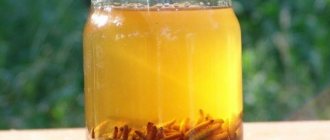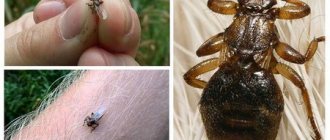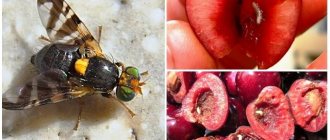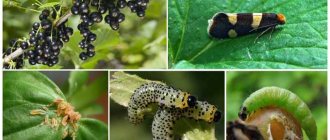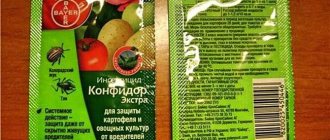Why is powdery mildew dangerous?
If destruction measures are not taken in time, the following consequences are possible:
- reduction in the total harvest volume due to loss of peduncles;
- death of vines and leaves;
- loss of berries.
Those fruits that still remain cannot be used in cooking or fresh, as they lose their taste and can be hazardous to health.
Signs of the disease
The symptoms of oidium that appear at different times of the year are different.
In spring the following signs appear:
- Yellowing of young shoots and leaves covered with a dirty white coating similar to flour.
- The edges of the leaves dry out and curl.
- Under the white coating, brown spots begin to appear on green shoots. If you try to wipe off the plaque, the smell of rotten fish appears.
- With severe damage, shoot growth is disrupted and their tissue begins to die.
In summer, these signs are slightly different:
- Flowers and young clusters dry out, and leaf ridges become brittle.
- As they grow, young berries become covered with dark spots, and later a mesh pattern appears on them and suberization occurs.
- The berries begin to crack and rot. The development of the disease on them may continue until harvest.
How to fight and what to treat for treatment?
Elimination involves a complex effect on the fungus: special chemicals and folk remedies are suitable, and an “emergency” method that can be used immediately when a parasite is detected is treatment with sulfur. But it is better to use such a substance at air temperatures of +20 degrees and above. In this case, the fungal tissues will better react with sulfur and absorb it.
Processing is carried out taking into account the following features:
- 100 grams of sulfur must be dissolved in ten liters of water.
- All plants are sprayed with the resulting mixture in the morning or evening.
- The procedure is carried out daily for one and a half to two weeks, depending on the degree of damage and the effectiveness of the method.
If you reduce the concentration by half, the composition can be used in the spring as a prophylactic agent. If sulfur does not help, it is necessary to use stronger biological agents or ready-made preparations.
Biological drugs
One of these remedies is humus. It is poured into a hundred-liter barrel in an amount that will take up a third of it. The remaining volume of the barrel is filled with warm water, then the container must be covered with a dense fabric that allows air to pass through for one week.
After this time, the liquid from the barrel is filtered to remove humus and used to spray on the grapes. Just two sprayings per season with an interval of 7 days are enough. Additionally, the procedure can be carried out after the start of flowering, if signs of oidium begin to appear on the inflorescences.
An alternative remedy is the drug phytosporin, which has the following advantages:
- the product is safe for people and animals;
- due to its wide spectrum of action, phytosporin simultaneously fights fungi, bacteria and harmful insects;
- additionally has a protective effect, creating a protective layer on the treated surfaces that prevents the development of diseases.
Fitosporin is sold in gardening stores in the form of a white powder or dark paste. Before use, it must be dissolved in water in accordance with the instructions in the instructions.
Chemicals
The most effective are chemical concentrated broad-spectrum agents.
These include:
- Aktara;
- Acrobat;
- Rubigan;
- Speed;
- Byleton;
- Vitaros;
- CM;
- Topaz.
Usually, to completely eliminate oidium spores, it is enough to treat the grapes every one and a half weeks (a total of four treatments will be required), but if you notice the disease in time and the parasite has just begun to spread, two treatments may be enough.
Such substances are very effective; they can harm the plant if the correct dosage is not followed when preparing a solution from the concentrate. They can also leave chemical burns on your hands, so it is recommended to wear protective gloves and long sleeves when preparing the solution and spraying.
Folk remedies
When preparing them, it is also necessary to observe the proportions of the components used so as not to damage the plant and at the same time achieve the desired effect.
The most effective are the following formulations:
- One part of mullein is poured with three parts of water and left for three days. The finished composition should be diluted again with water in a ratio of 1 to 3.
- To 4 liters of water add a tablespoon of liquid soap and three tablespoons of soda. The composition can be used immediately.
- Add two tablespoons of mustard powder to ten liters of boiling water and mix thoroughly. You can spray the grapes only after the mixture has completely cooled.
- One kilogram of sifted ash is diluted in 10 liters of warm water and infused for five days. Once a day, the composition must be stirred so that the ash does not settle in lumps and dissolve. Before use, add a tablespoon of grated laundry soap.
Each of these products can be used once every few days for a long period, since these compounds are not dangerous to the plant. But if no effect is observed from them after two weeks, it is better to use store-bought chemicals that will cope with the fungus at any stage of its development.
Causes of oidium
Oidium is a fungal disease. Its causative agent is called Uncinula necator Burr. (or Oidium tuckeri Berk. ). In Europe, oidium has been known since the mid-19th century, when it was imported from North America along with plant foods.
Other names for this disease: powdery mildew, Oidium, Uncinula Necator and the popular name - ashberry, and also the often used incorrect name - iodium on grapes
In the form of mycelium, the culprit of the disease overwinters in the body of the plant - in tissues such as buds or annual shoots. It is also found in fallen leaves and clusters in autumn. That is why it is important to remove and destroy various organic debris before wintering, so that pathogens do not appear in the spring.
In spring, the mycelium forms so-called conidia (spores). When warm days arrive, short chains of conidia are picked up by the wind and carried throughout the area over considerable distances, affecting new vineyards.
Primary infection of plants occurs with virtually no external signs. The appearance of powdery mildew on grapes is the second stage of the disease.
Tiny spores can cause several waves of infection in just one season. High humidity is not necessary for the development of the disease, and the temperature range is from +5˚С to approximately +35˚С. If the winter has been mild and the spring has been warm and humid, signs of the disease may appear very early. And first of all, the youngest shoots will suffer.
Prevention in spring, summer and winter
It is impossible to completely protect a plant from diseases and pests, but you can reduce the risk of powdery mildew if you follow the following preventive recommendations:
- during the growing season, grapes can be sprayed with one percent Bordeaux mixture;
- at the first signs of oidium, it is necessary to stop feeding, since the components included in it only contribute to the development of the fungus (with the exception of phosphorus-potassium fertilizers);
- the vineyard must be regularly cleaned of dry, diseased and dead plants, as these are the main sources of the spread of harmful microorganisms.
In the complex fight against powdery mildew, caution should be exercised if it is decided to use several chemical agents at once. Sometimes this combination leads to burns of leaves and vines, so if there is a need for such treatment, the concentration of the original product in each solution should be reduced by as many times as the drugs are used in total. For example, if two substances are used, their concentration should be 50% of that recommended in the instructions.
3.7 / 5 ( 4 voices)
Grape diseases
To begin with, it is worth noting that grape diseases can be non-infectious and infectious. What is the difference?
Non-communicable diseases are those that are associated with weather conditions (heat, cold, hail) that can affect the plant. It may also be unfavorable soil conditions - excessive acidity or alkalinity, poor drainage and lack of oxygen, which leads to a lack of nutrition for the grape bush.
All this can directly affect the quantity and quality of the harvest, the shedding and drying of berries and leaves, the proliferation of harmful bacteria, fungi or viruses.
Infectious diseases - bacteria, fungal spores and viruses - are transmitted from diseased plants to healthy ones. They can be carried by rain, wind, fog, animals and even humans. Also, a healthy grape bush can become infected through gardening tools, such as pruning shears, if it has previously been in contact with a diseased plant and has not been treated.
Folk remedies
The use of folk remedies for the treatment of powdery mildew is effective only in the early stages or for prevention purposes. If the plaque is not detected immediately, then only fungicides can help.
- Take 2 tbsp. l. dry mustard and dissolve in 10 l. boiling water After the solution has cooled, apply it to the damaged areas.
- Potassium permanganate is a good anti-plaque remedy. 3 g dissolve in 10 l. water and treatment is carried out every 5 days. In total you can spray 3 times.
- Garlic solution is also an effective folk remedy not only against powdery mildew, but also against insect pests. 25 g of chopped garlic are poured into 1 liter. hot water. Let the solution brew and apply it to the grapes after a day.
- Mullein helps against all types of fungus. Pour water in a ratio of 1:3 and leave in a dark place for 3 days. Then dilute with water 2 times and can be used to treat bushes.
- Baking soda 1 tbsp. l. diluted in 4 l. water. Add liquid laundry soap to the solution and mix thoroughly. Treat every week 3 times.
Advantages:
- environmental friendliness;
- availability of constituent ingredients;
- positive effect on parasitic disease after several treatments.
Flaws:
- low efficiency at one time;
- Sometimes it takes a lot of time to create a medicinal mixture.
What to do if treatment doesn't help
It is believed that timely prevention helps prevent the appearance of oidium on grapes. Fungicides also do an excellent job with plants already infected with oidium. The main thing is not to start the disease at all, and to carry out repeated procedures. But anything can happen, and beginners may not always be able to spot the problem in time or even simply not know about it.
What to do if powdery mildew was not detected in time, the fungus managed to spread throughout the grapes and treatment does not help? First, try double dosages of drugs for oidium:
- Quadris,
- Topaz,
- Soon,
- Tiovit Jet,
- Strobe,
- Quadris,
- You can also add Ecosil (it is compatible) - it will be a real bomb against oidium fungus.
- and etc.
Carry out 2-3 treatments with a break of 2-3 days, replacing the drugs each time. Then the usual prophylaxis is carried out. Before covering, apply an eradication treatment to the vine with a 3-5% solution of ferrous sulfate.
In the spring, after opening the grapes, treat with a 3-5% solution of copper sulfate; you can use Azofos instead (250 ml per bucket of 10 liters of solution). Start with the usual preventative treatments with tank mixtures in normal dosages.
If the vineyard is so badly affected that there are almost no leaves left, then do not plant the bushes yet - the plant will accumulate nutrition due to the growing shoots.



